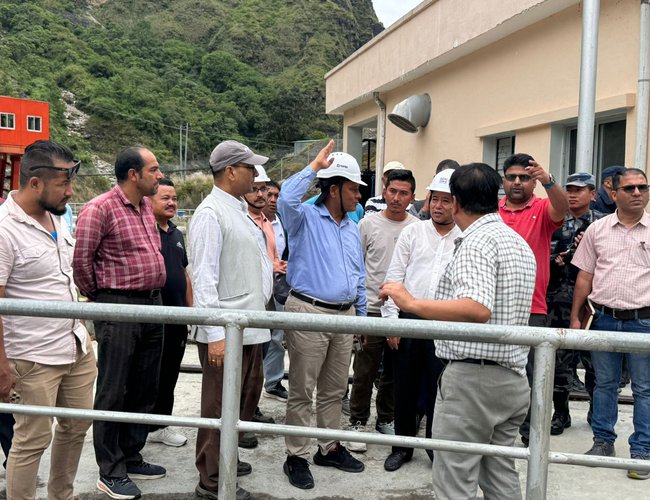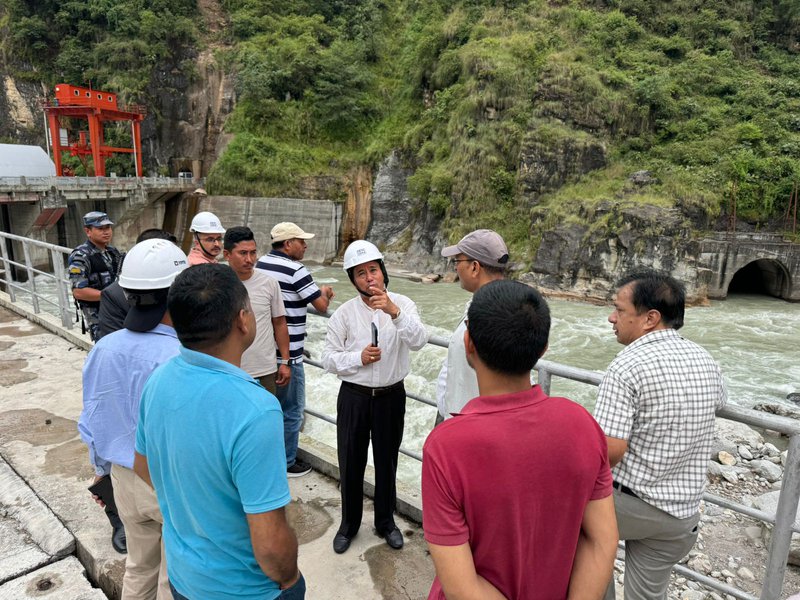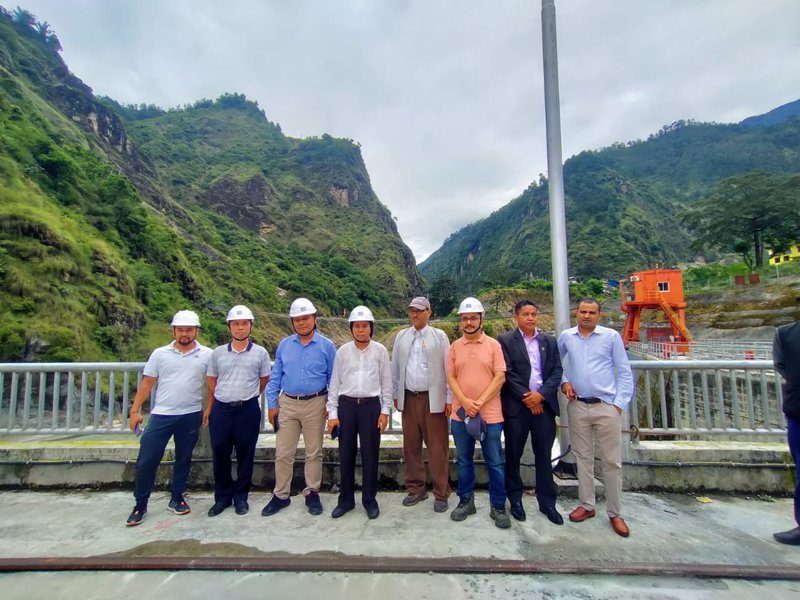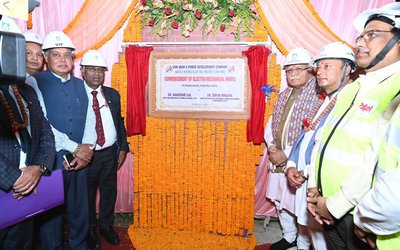

Just two weeks prior, an agreement was reached to commence the construction of the 220 kV transmission line essential for transmitting electricity generated by the Middle Bhotekoshi Hydropower to the Barahabise Substation. On the morning of September 21, Minister of State for Energy, Water Resources, and Irrigation Purna Bahadur Taman, accompanied by NEA Managing Director Kul Man Ghising, visited the construction site to assess progress.
With extensive experience in the construction industry, State Minister Taman is adept at addressing the concerns of local communities and contractors. Consequently, he chose to inspect the site alongside Managing Director Ghising. During their visit, they instructed the project management team, consultants, and construction personnel to ensure that electricity generation is achieved within the next month.
MD Ghisin has dedicated nearly all of his public holidays, including Saturdays, to overseeing construction sites. This week, he was joined by Minister Tamang.
The 102 MW Middle Bhotekoshi Hydropower Project, which has faced nearly a year of delays due to local opposition regarding the installation of the conductor for the 220 kV transmission line, is now poised to commence electricity generation within a month.
Following a consensus reached with local residents concerning the construction of a two-kilometer transmission line from the project's switchyard in Bahrbise Municipality-5 to the NEA's Bahrbise Substation in District 3, the wire installation process has commenced. The work on the 220 kV single circuit transmission line is expected to be finalized before the Dashain festival.
The local opposition was resolved after an agreement was signed on September 13, in the presence of several officials, including Minister of Power, Water Resources and Irrigation Deepak Khadka, Minister of State Purna Bahadur Tamang, Federal Member of Parliament for Sindhupalchok-2 Mohan Bahadur Basnet, Joint Secretary of the Ministry Sandeep Kumar Dev, NEA Managing Director Kulman Ghising, Head of Bahrbise Municipality Balkrishna Basnet, Ward Presidents, Assistant Chief District Officer, and the President of the Chamber of Commerce and Industry.
The resumption of construction on the transmission line, which had been on hold for approximately 14 months, is now underway due to this agreement. The project, overseen by Chilime Jalvidyut Company Limited, a subsidiary of the Nepal Electricity Authority (NEA), is in the final phase of the 102 MW Middle Bhotekoshi Hydropower Project, which is anticipated to commence electricity generation within a month.
During his visit, State Minister Tamang urged the contractors to accelerate the remaining tasks and ensure that all project management personnel remain on-site until completion. Once the Middle Bhotekoshi hydropower project begins producing electricity, the Bahrbise substation, constructed by NEA, will also be energized with this power. The Barabishe 220-132 kV substations were completed last year.
In light of ongoing obstructions, NEA has implemented a temporary alternative solution for the evacuation of electricity from Middle Bhotekoshi. The electricity transmitted to the Bahrbise substation via the 220 kV transmission lines will be stepped down to 132 kV at the substation and subsequently delivered to the national grid through the 132 kV transmission line.
To facilitate this, the company is currently working on utilizing the 132 kV transmission line established by Shivashree Hydropower, the developer of the 22 MW Upper Chaku A Hydropower Project, to connect to the Bahrbise Substation.
The project is nearing completion. Following the construction of the dam, water has been released for testing purposes. The main tunnel, measuring 7,124 meters in length, has been completed. Although the water filling test commenced in February of the previous year, experts identified water leakage in approximately 1,400 meters of the main tunnel. After the necessary repairs and enhancements are finalized, the tunnel will undergo further testing. Currently, the cleaning process of the tunnel is underway, and it is scheduled to be filled with water in 15 days.
The civil construction work at the power plant has been finalized, and the installation and testing of the electromechanical equipment (dry test) are nearing completion. Once water is discharged from the tunnel, the wet testing of the equipment will commence. All outstanding tasks are expected to be completed within one month, with the objective of initiating power generation.

The construction of the Middle Bhotekoshi project faced several challenges, including the Jure landslide, a significant earthquake, disputes along the Nepal-India border, flooding of the Bhotekoshi River, the impact of Covid-19, and subpar performance by contractors.
The projected cost of the project was initially estimated at Rs. 12 billion, excluding interest during the construction phase, at the time the loan agreement was established with the Employees' Provident Fund. The revised estimated cost of the project, also excluding interest for the construction period, is now Rs. 16 billion. The original total cost of the project was financed equally, with 50 percent sourced from equity and 50 percent from debt.
Among the founding shareholders, who collectively hold 51 percent of the company's issued capital, the distribution includes 10 percent from the NEA, 37 percent from Chilime Jalvidyut Company Limited, and 1 percent each from Sindhupalchok Hydropower Co. Ltd., Nepal Arnico Hydropower Company Ltd., Sindhu Investment Company Pvt. Ltd., and Sindhu Bhotekoshi Hydropower Ltd.
The remaining 49 percent is held by ordinary shareholders, which includes 19.5 percent from employees of the Provident Fund, 3.5 percent from employees of the founding organizations, 1 percent from employees of the lending organizations, 10 percent from residents of Sindhupalchok, and 15 percent from the general public.
The company has successfully raised capital through the issuance of ordinary shares. The project is expected to produce 542 million units of electricity annually. The NEA will purchase electricity generated by the project during the winter and rainy seasons at rates of Rs. 8.40 and Rs. 4.80 per unit, respectively. The company anticipates an annual revenue of Rs. 2.08 billion.
- TEACHERS ON STRIKE: Students' Future In Jeopardy
- Apr 25, 2025
- NEPAL-THAILAND: Joint Business Council
- Apr 13, 2025
- BIMSTEC SUMMIT: Nepal’s Stand
- Apr 11, 2025
- IME GROUP: Expands Into Paper Industry
- Mar 24, 2025
- CPN UML: Instigated By India
- Mar 23, 2025















